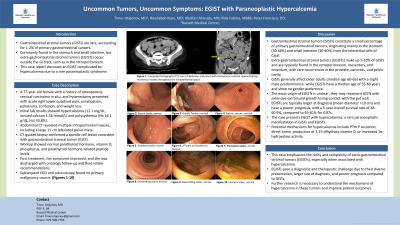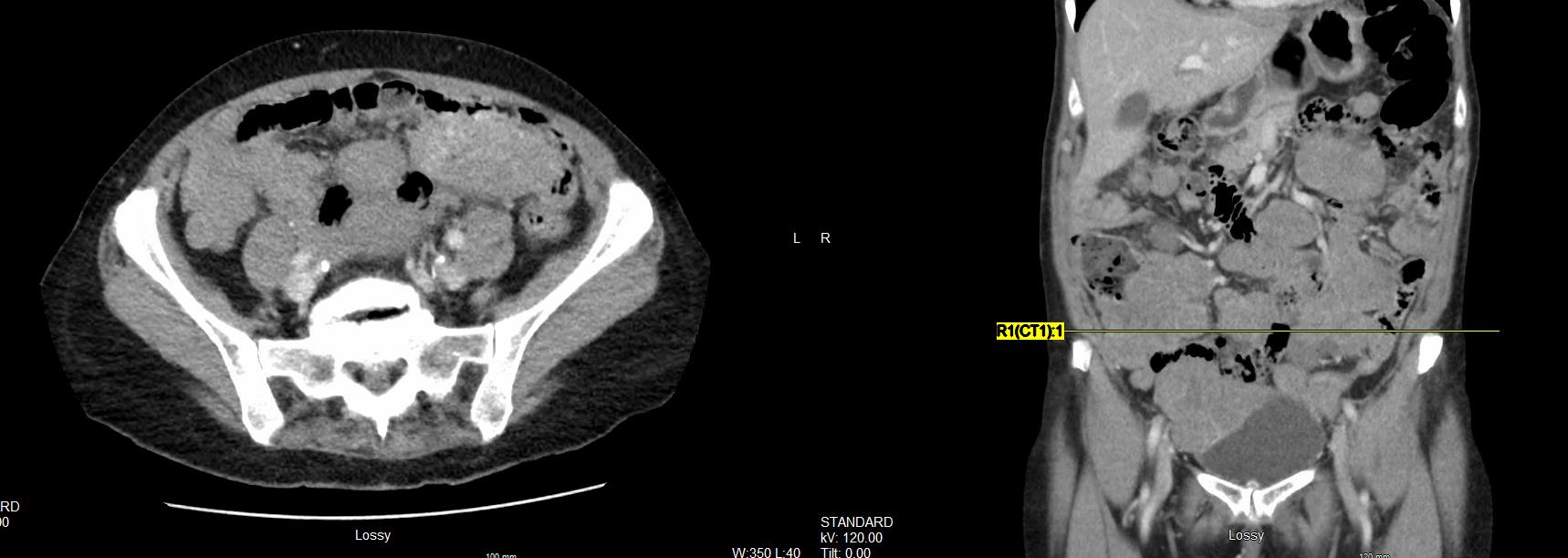Monday Poster Session
Category: Small Intestine
P3242 - Uncommon Tumors, Uncommon Symptoms: EGIST with Paraneoplastic Hypercalcemia
Monday, October 28, 2024
10:30 AM - 4:00 PM ET
Location: Exhibit Hall E

Has Audio

Timur Otajonov, MD
Bassett Medical Center
Cooperstown, NY
Presenting Author(s)
Timur Otajonov, MD, Roudabeh Kiani, MD, Rida Fatima, MD, Peter Francisco, DO, Ahmady Abolfazl, MD
Bassett Medical Center, Cooperstown, NY
Introduction: Gastrointestinal stromal tumors (GISTs) are rare, accounting for 1-2% of primary gastrointestinal cancers. They mainly develop from interstitial cells of Cajal in the stomach and small intestine. However, Extra-gastrointestinal stromal tumors (EGISTs) originate outside the GI tract, in places like the retroperitoneum, mesentery, and omentum. This case report presents an EGIST complicated by hypercalcemia due to a rare paraneoplastic syndrome, highlighting the importance of recognizing atypical manifestations for accurate diagnosis and management.
Case Description/Methods: A 77-year-old female with a history of osteoporosis, cervical carcinoma in situ, and possible choriocarcinoma/uterine cancer (status post-hysterectomy) presented with acute right lower quadrant abdominal pain, constipation, frequent urination, progressive confusion, and weight loss. She had hypertension (BP 151/88 mmHg) and dry oral mucosa, with a non-tender, non-distended abdomen and normal bowel sounds. Lab results showed hypercalcemia (12.1 mg/dL, ionized calcium 1.56 mmol/L) and polycythemia (hemoglobin 16.1 g/dL, hematocrit 43.8%).
A CT scan revealed multiple masses in the intraperitoneal space, including an 11 cm mass in the pelvis extending into the right lower quadrant, and a 5.1 cm ovoid mass in the right Morison's pouch. She underwent a CT-guided biopsy of the right lower quadrant mass. The biopsy showed a spindle cell lesion consistent with a gastrointestinal stromal tumor (GIST).
An EGD with colonoscopy later showed no primary source of malignancy.
Discussion: GISTs typically affect older adults (median age 60-65) with a slight male predominance, while EGISTs affect adults with a median age of 55-60 with no gender preference. The exact origin of EGISTs is unclear, though they may be GISTs with extensive extramural growth. Both GISTs and EGISTs express CD117 (c-KIT) and DOG-1, but EGISTs may also show positivity for CD34 and smooth muscle actin (SMA).
GISTs are generally smaller at diagnosis compared to EGISTs, which often exceed 10 cm. GISTs have better survival rates (65-81% 5-year overall survival) compared to EGISTs (38-60.9%). In the presented case, the patient had an EGIST and hypercalcemia, contributing to symptoms like confusion. Hypercalcemia is a rare paraneoplastic manifestation in both GISTs and EGISTs, caused by mechanisms such as parathyroid hormone-related protein (PTHrP) secretion, direct tumor production of calcitriol, or increased activity of the enzyme 1α-hydroxylase.

Disclosures:
Timur Otajonov, MD, Roudabeh Kiani, MD, Rida Fatima, MD, Peter Francisco, DO, Ahmady Abolfazl, MD. P3242 - Uncommon Tumors, Uncommon Symptoms: EGIST with Paraneoplastic Hypercalcemia, ACG 2024 Annual Scientific Meeting Abstracts. Philadelphia, PA: American College of Gastroenterology.
Bassett Medical Center, Cooperstown, NY
Introduction: Gastrointestinal stromal tumors (GISTs) are rare, accounting for 1-2% of primary gastrointestinal cancers. They mainly develop from interstitial cells of Cajal in the stomach and small intestine. However, Extra-gastrointestinal stromal tumors (EGISTs) originate outside the GI tract, in places like the retroperitoneum, mesentery, and omentum. This case report presents an EGIST complicated by hypercalcemia due to a rare paraneoplastic syndrome, highlighting the importance of recognizing atypical manifestations for accurate diagnosis and management.
Case Description/Methods: A 77-year-old female with a history of osteoporosis, cervical carcinoma in situ, and possible choriocarcinoma/uterine cancer (status post-hysterectomy) presented with acute right lower quadrant abdominal pain, constipation, frequent urination, progressive confusion, and weight loss. She had hypertension (BP 151/88 mmHg) and dry oral mucosa, with a non-tender, non-distended abdomen and normal bowel sounds. Lab results showed hypercalcemia (12.1 mg/dL, ionized calcium 1.56 mmol/L) and polycythemia (hemoglobin 16.1 g/dL, hematocrit 43.8%).
A CT scan revealed multiple masses in the intraperitoneal space, including an 11 cm mass in the pelvis extending into the right lower quadrant, and a 5.1 cm ovoid mass in the right Morison's pouch. She underwent a CT-guided biopsy of the right lower quadrant mass. The biopsy showed a spindle cell lesion consistent with a gastrointestinal stromal tumor (GIST).
An EGD with colonoscopy later showed no primary source of malignancy.
Discussion: GISTs typically affect older adults (median age 60-65) with a slight male predominance, while EGISTs affect adults with a median age of 55-60 with no gender preference. The exact origin of EGISTs is unclear, though they may be GISTs with extensive extramural growth. Both GISTs and EGISTs express CD117 (c-KIT) and DOG-1, but EGISTs may also show positivity for CD34 and smooth muscle actin (SMA).
GISTs are generally smaller at diagnosis compared to EGISTs, which often exceed 10 cm. GISTs have better survival rates (65-81% 5-year overall survival) compared to EGISTs (38-60.9%). In the presented case, the patient had an EGIST and hypercalcemia, contributing to symptoms like confusion. Hypercalcemia is a rare paraneoplastic manifestation in both GISTs and EGISTs, caused by mechanisms such as parathyroid hormone-related protein (PTHrP) secretion, direct tumor production of calcitriol, or increased activity of the enzyme 1α-hydroxylase.

Figure: Figure 1: computed tomography (CT) scan of abdomen and pelvis with intravenous contrast demonstrating numerous masses throughout the intraperitoneal space
Disclosures:
Timur Otajonov indicated no relevant financial relationships.
Roudabeh Kiani indicated no relevant financial relationships.
Rida Fatima indicated no relevant financial relationships.
Peter Francisco indicated no relevant financial relationships.
Ahmady Abolfazl indicated no relevant financial relationships.
Timur Otajonov, MD, Roudabeh Kiani, MD, Rida Fatima, MD, Peter Francisco, DO, Ahmady Abolfazl, MD. P3242 - Uncommon Tumors, Uncommon Symptoms: EGIST with Paraneoplastic Hypercalcemia, ACG 2024 Annual Scientific Meeting Abstracts. Philadelphia, PA: American College of Gastroenterology.
